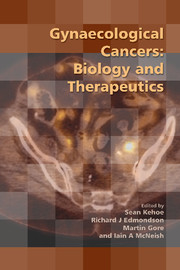Book contents
- Frontmatter
- Contents
- Participants
- Declarations of personal interest
- Preface
- SECTION 1 BIOLOGY OF GYNAECOLOGICAL CANCERS: OUR CURRENT UNDERSTANDING
- SECTION 2 THE TRANSLATION OF BIOLOGY TO THE CLINIC
- SECTION 3 IMAGING AND THERAPY: STATE OF THE ART
- SECTION 4 WHAT QUESTIONS ARE BEING ASKED BY CURRENT CLINICAL TRIALS?
- SECTION 5 CONSENSUS VIEWS
- 18 Consensus views arising from the 60th Study Group: Gynaecological Cancers: Biology and therapeutics
- Index
18 - Consensus views arising from the 60th Study Group: Gynaecological Cancers: Biology and therapeutics
from SECTION 5 - CONSENSUS VIEWS
Published online by Cambridge University Press: 05 February 2014
- Frontmatter
- Contents
- Participants
- Declarations of personal interest
- Preface
- SECTION 1 BIOLOGY OF GYNAECOLOGICAL CANCERS: OUR CURRENT UNDERSTANDING
- SECTION 2 THE TRANSLATION OF BIOLOGY TO THE CLINIC
- SECTION 3 IMAGING AND THERAPY: STATE OF THE ART
- SECTION 4 WHAT QUESTIONS ARE BEING ASKED BY CURRENT CLINICAL TRIALS?
- SECTION 5 CONSENSUS VIEWS
- 18 Consensus views arising from the 60th Study Group: Gynaecological Cancers: Biology and therapeutics
- Index
Summary
Biology
There is a pressing need to reclassify gynaecological cancers. Through recent work we have begun to realise that the most common type of ‘ovarian cancer’, high-grade serous cancer, is characterised by mutation of the p53 (TP53) gene. This has allowed the identification of precursor lesions in the fallopian tube and the realisation that in fact much, if not all, of this type of cancer probably originates in the tube itself. Thus serous cancer of the corpus, tube, ovary and peritoneum are almost certainly variants of the same disease. Similarly, clear-cell and endometrioid cancers also share many molecular characteristics, including driver mutations of PTEN, and this is irrespective of whether they appear to originate in the ovary or the uterine corpus.
Changing the taxonomy and nomenclature of gynaecological cancers is not just an academic exercise. If we are to make serious inroads into improving the management of these diseases then we need to think about these cancers as distinct entities, types not sub-types of cancer, and initially design our clinical trials to reflect this. Ultimately, based on the results of these trials, we would envisage the development of different management strategies for each type.
Keywords
- Type
- Chapter
- Information
- Gynaecological CancersBiology and Therapeutics, pp. 245 - 248Publisher: Cambridge University PressPrint publication year: 2011



